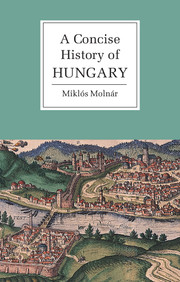Book contents
- Frontmatter
- Contents
- List of illustrations
- Acknowledgements
- Chronology
- 1 FROM THE BEGINNINGS UNTIL 1301
- 2 GRANDEUR AND DECLINE: FROM THE ANGEVIN KINGS TO THE BATTLE OF MOHÁCS, 1301–1526
- 3 A COUNTRY UNDER THREE CROWNS, 1526–1711
- 4 VIENNA AND HUNGARY: ABSOLUTISM, REFORMS, REVOLUTION, 1711–1848/9
- 5 RUPTURE, COMPROMISE AND THE DUAL MONARCHY, 1849–1919
- 6 BETWEEN THE WARS
- 7 UNDER SOVIET DOMINATION, 1945–1990
- 8 1990, A NEW DEPARTURE
- Bibliographical notes
- Index
4 - VIENNA AND HUNGARY: ABSOLUTISM, REFORMS, REVOLUTION, 1711–1848/9
Published online by Cambridge University Press: 05 June 2014
- Frontmatter
- Contents
- List of illustrations
- Acknowledgements
- Chronology
- 1 FROM THE BEGINNINGS UNTIL 1301
- 2 GRANDEUR AND DECLINE: FROM THE ANGEVIN KINGS TO THE BATTLE OF MOHÁCS, 1301–1526
- 3 A COUNTRY UNDER THREE CROWNS, 1526–1711
- 4 VIENNA AND HUNGARY: ABSOLUTISM, REFORMS, REVOLUTION, 1711–1848/9
- 5 RUPTURE, COMPROMISE AND THE DUAL MONARCHY, 1849–1919
- 6 BETWEEN THE WARS
- 7 UNDER SOVIET DOMINATION, 1945–1990
- 8 1990, A NEW DEPARTURE
- Bibliographical notes
- Index
Summary
When in 1711 the insurrectional army laid down its weapons and Prince Ferenc Rákóczi began his exile – first in Poland and then in France – a century of momentous change was just dawning in Europe. Whereas France had dominated the previous period, with the death of Louis XIV its power was waning and England, ruler of the waves, was now becoming preponderant. England's main preoccupation was to establish an equilibrium among the continental powers that at this time included a few newcomers: the Prussia of Frederick William I, the ‘soldier-king’, and of his son Frederick II, the Great (1740–86), with its modern and formidable army and the Russia of Peter I, the Great (1682–1725), which had emerged as a great power. Under the empress, Catherine II, the Great (1762–96), the Russian Empire would later expand at the expense of the Ottoman Empire and the three-part division of Poland. As for the Habsburgs, their hold over Spain had been broken (1700), their hold over Germany weakened, but they succeeded in constructing Austria and their hereditary provinces, centre of the empire, at the frontier of the Hungarian kingdom. King Charles III, Charles VI (1711–40) as Holy Roman emperor, and Maria Theresa (1740–80) made Vienna the splendid capital of the monarchy. Viennese power was put to the test by a series of crises triggered by Frederick the Great: the War of the Austrian Succession (1740–8), the Seven Years' War (1756–63), and the last of the Turkish wars.
- Type
- Chapter
- Information
- A Concise History of Hungary , pp. 139 - 200Publisher: Cambridge University PressPrint publication year: 2001

